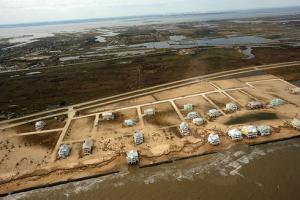Coastal perilRising seas threaten 1.9 million U.S. homes with current value of $882 billion
Typically when we talk about “underwater” homes, we are referring to negative equity. But there is a more literal way a home can be underwater: Rising sea levels, and the flooding likely to come with them, could inundate millions of U.S. homes worth hundreds of billions of dollars. If sea levels rise as much as climate scientists predict by the year 2100, almost 300 U.S. cities would lose at least half their homes, and 36 U.S. cities would be completely lost. The total combined current value of all homes at risk of being underwater with a 6-feet rise in sea levels is $882 billion.

Storm-moved sand may presage damage to waterfront homes by rising sea level // Source: commons.wikimedia.org
Typically when we talk about “underwater” homes, we are referring to negative equity. But there is a more literal way a home can be underwater: Rising sea levels, and the flooding likely to come with them, could inundate millions of U.S. homes worth hundreds of billions of dollars.
Zillow, a leading real estate firm, says that based on its calculations, it may turn out that actual water poses almost as much of a problem for the housing market in the future as negative equity has in the past (in early 2012, when negative equity was at its highest in the United States, the total dollar amount of negative equity was $1.2 trillion. The total combined current value of all homes at risk of being underwater with a 6-feet rise in sea levels is $882 billion).
To quantify the impact of rising sea levels, Zillow used maps released by the National Oceanic and Atmospheric Administration (NOAA) showing which parts of costal states will be underwater if sea levels rise by six feet (NOAA provides data on which parts of coastal states will be flooded if sea levels rise by varying amounts. Zillow combined this data with the location and value of homes in each state and city to determine the current value of housing at risk if sea levels rise to six feet).
Why six feet? Some estimates suggest sea levels will rise that much by the year 2100 if climate change continues unchecked. Using that data in conjunction with Zillow’s database of information on more than 100 million homes nationwide, Zillow determined which properties were at risk of being submerged (at least their ground floors) in the next century or so and what they are currently worth.
Nationwide, almost 1.9 million homes (or roughly 2 percent of all U.S. homes) — worth a combined $882 billion — are at risk of being underwater by 2100. And in some states, the fraction of properties at risk of being underwater is alarmingly high. More than 1 in 8 properties in Florida are in an area expected to be underwater if sea levels rise by six feet, representing more than $400 billion dollars in current housing value. In Hawaii, almost 1 in 10 homes are at risk.
The numbers are even more alarming when looking at individual cities. Given the risk that Florida and Hawaii face, it should come as no surprise that Miami and Honolulu top the list of large cities with a significant number of properties at risk from global warming and subsequent rises in sea levels. But they are not alone. More than 1 in 6 Boston homes are at risk, and New Yorkers may find almost 3 percent of homes in the city underwater if sea levels rise in line with climatologists’ predictions.
Zillow says that it is important to note that 2100 is a long way off, and it is certainly possible that communities take steps to mitigate these risks. Then again, given the enduring popularity of living near the sea despite its many dangers and drawbacks, it may be that even more homes will be located closer to the water in a century’s time, and these estimates could turn out to be very conservative. Either way, left unchecked, it is clear the threats posed by climate change and rising sea levels have the potential to destroy housing values on an enormous scale.
“This is going to be a massive issue worldwide,” Michael Gerrard of Columbia University, who directs the Sabin Center for Climate Change Law, told the Washington Post in a recent interview. “We don’t know yet the exact pace, but we know it’s coming. A certain amount is unavoidable.”
— Read more in Melissa Allison, The Effect of Rising Sea Levels on Coastal Homes (Zillow, 2 August 2016)
